- Bernard Preston homepage
- Honey Mead
- What Is the Best Source of Honey for Mead
What is the best source of honey for mead?
What is the best source of honey for mead is an important question. We discuss getting it from the wax gleanings and from uncapped combs.
Let's start with a little analogy. You are planning to build a very nice and quite expensive house; it will be a lot of work. Would you consider a cheap plot next to a highway or adjacent to an industrial area?
Likewise mead is an exclusive and quite expensive drink. Are you thinking of using supermarket honey which will certainly have been heated and likely adulterated with high-fructose corn syrup?[3]
Whilst meading is not intrinsically difficult you will be spending quite a lot of time fiddling with syphons, pH meters and hydrometers; not to mention the washing, sterilising and rinsing of equipment.
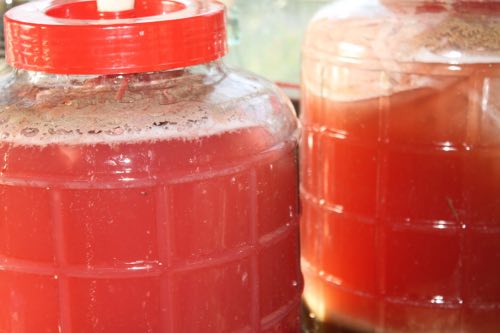 Carboys of cherry-guava mead
Carboys of cherry-guava meadMelomels
Personally I prefer a melomel to a straight mead; the alcohol serves to preserve the nutrients in the fruit. But then there is yet more time spent picking for example the cherry guavas, berries or peppadews.
A cherry guava melomel is really my favourite; but it takes nearly two hours to pick the fruit. Would you use anything other than the best source of honey for your mead?
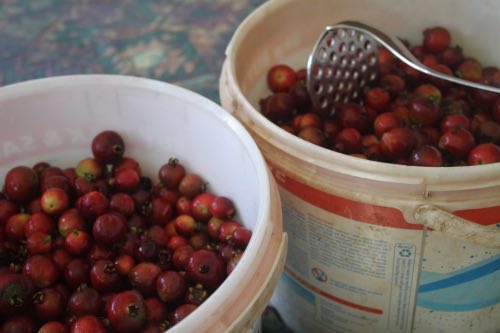 Cherry guavas for brewing mead
Cherry guavas for brewing meadGood honey for mead
Good honey for mead should be completely unheated and only lightly-filtered; the pollen is an essential yeast nutrient.
The pollen provides the protein, fatty acids and micronutrients for the bees; and for the yeast cells that turn the sugars into alcohol. It has benefits for us too for that matter.
For this reason I take a fringe view on "pure" honey; filtering is a form of processing that extracts one of the best parts. That's like flour from which the bran and germ have been removed; it will make us fat and increases the likelihood of insulin-resistance.
In similar vein natural unheated honey has a low GI; astonishingly it actually reduces the fasting blood glucose of diabetics. But once bottlers process it and extract the pollen, the glycemic index shoots up; above that of sugar.
What is the best source of honey for mead? Here I present three possibilities.
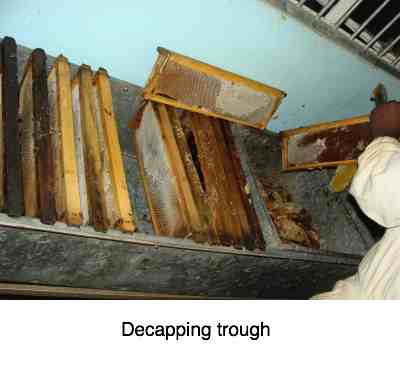
1. Straight from the bottling tank
Natural honey is uncapped, centrifuged and lightly filtered; and then allowed to stand for a few days for the bits and pieces to float to the surface. This is undoubtedly the best; but it's very expensive. There is about 250g in each 750ml bottle of mead; half a pound.
2. From the gleanings
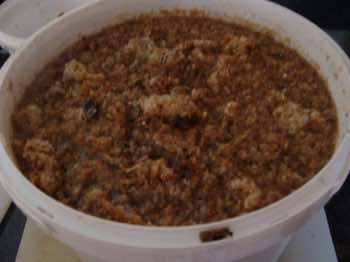
When the beekeeper "decaps" the comb quite a lot of prime honey comes away with the wax. The meader will dissolve it in warm but not hot water, filter it and then make use of it for brewing his or her tipple.
This mess of honey and wax contains dead bees and a lot of junk; it should be strained before using it to brew mead.
3. From uncapped honey
As a rule of thumb the beekeeper harvests combs that are at least 2/3 capped; this is the prime, natural honey.
The remaining one-third that is uncapped still has too much water; and can be used for making mead.
So the beekeeper puts the combs that have not been decapped into the extractor; this not fully-ripe honey will be spun out and collected for mead. Add 10% more to the recipe to allow for the lower concentration of sugars.
Then the frames are removed from the extractor, decapped in the usual way and returned for spinning; this then is the prime honey that is bottled.
What is the best source of honey for mead? All three of these would pass muster.
If you are not a beekeeper
These best sources of honey for mead all assume you are a beekeeper. If you are not, are there any other options?
That from sugar cane is one reasonable option; the nectar doesn't actually come from the flower but the bees collect it from the stalk when it has been slashed during harvesting. Many ardent enthusiasts contest that it is not honey at all; second best but half the price of the prime product.
In fact when I see the price of some retail bottles of mead I can state with certainty that it is not brewed using prime honey; buyer beware. It's a dark and deceitful world. First choice undoubtedly is to start keeping your own bees.
Then you know precisely what is the best source of honey for mead; that from your own hives.
Now it's straight forward
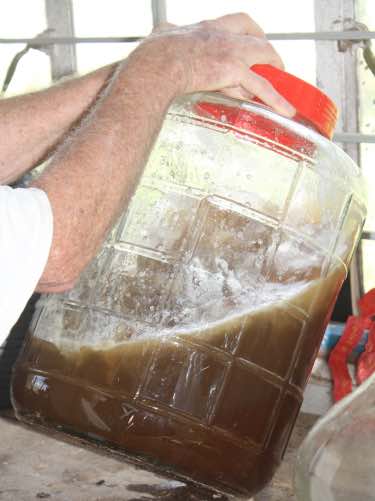 Aerating your mead
Aerating your meadNow brewing your mead is really pretty straightforward. Pour the required amount of honey into a carboy; add a little unchlorinated water. Aerate it thoroughly for ten minutes by rocking the boat.
Then add the fruit in a bag if you are making a melomel, fill to about 7cm from the top and add the wine yeast. Fit the bubbler to the bung to keep air out.
Six weeks later you can rack your melomel for the first time; and then allow it to mature and clear for six months or longer before bottling.
Why go to all this trouble?
Why go to all this trouble when you can purchase your favourite tipple off the shelf; probably for little more that the price of a bottle of mead? In fact commercial wine may be cheaper.
For me there are several reasons. Firstly I just love fascinating processes and there are not many more intriguing than watching yeast cells turn sugars into alcohol; it's very complicated biochemistry.The bleep from the bubbler is music in a meader's ear.
And secondly there is strong evidence that all commercial alcohol increases the risk of cancer; even one glass of wine per week, particularly of the breast and prostate.
But this does not appear to be the case with natural wines and beers that have not been pasteurised; and no sulphites added[1].
Make cherry guava mead
I continue for clarity to call this a mead; but because we have added fruit to the honey it is now known as a melomel. To give it astringency we make a tea from the leaves; they have proven properties of lowering blood glucose for the diabetic[2].
Once bubbling stops diabetics need have no general anxiety about drinking a mead; most of the sugars have been turned into alcohol.
I myself am prediabetic but my HbA1c has returned to a very normal 5.4 since giving up all refined carbs and limiting sugar to around 3 teaspoons per day; despite drinking two glasses of mead every night with supper.
Brewing your own mead may turn you into a "functional" alcoholic; one who drinks regularly but doesn't ever get drunk and is able to live a completely normal life. Beware though that your tipple remains a servant; it has the desire to become master of the house!
Both the fruit and the leaves have a wide array of nutrients, vitamins and minerals; in particular potassium which has proven properties of lowering blood pressure.
Soluble fibre
Cherry guavas contain a large amount of soluble fibre called pectin. This aids in preventing cholesterol build up and constipation; and by supplying nutrients to the microbiome helps to normalise generalised inflammation in the body.
Only 5% of those enjoying typical grocery store food are getting the recommended amount of fibre; it comes as no surprise that diseases of the bowel are surging.
In fact in addition to the pectin a melomel contains living yeast cells; it is a true probiotic contributing both to the normal flora and the need of the gut for fibre.
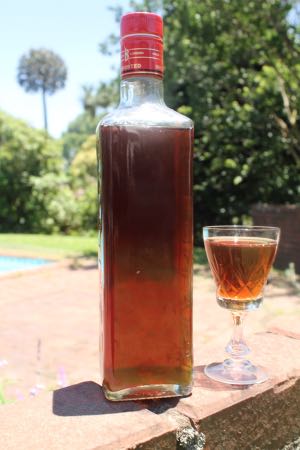 Wassail! Prost. Cheers.
Wassail! Prost. Cheers.What is the best source of honey for mead?
What is the best source of honey for mead? Keep your own bees, of course. Must it be unheated? Very definitely and don't forget about the role of the pollen in supplying nutrients to both the yeast and us; especially the prostate gland.
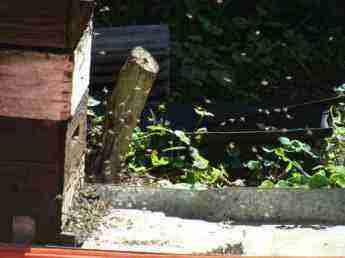
Swarming instinct
The African bee is an inveterate swarmer; at the beginning of a flow the colony breeds a new queen and the old monarch leaves with half the workforce and a lot of honey. It is a big loss to the 'keeper.
Formerly having to wait for the combs to be nearly capped exacerbated this instinct. Now taking every drop, mature or otherwise as a source of honey for mead actually helps to reduce swarming. Obviously the beekeeper would not do that as the flow is coming to an end; one has to leave them with some stores.
Vegans accuse us of exploiting the bees; there may be some truth in it. But 'keepers know that if they abuse their little friends there will be a smaller return next year; most of us are very conscientious.
When browsing use right click and "Open Link in New Tab" or you may get a bad gateway signal.
Newsletter
Our newsletter is entitled "create a cyan zone" at your home, preserving both yourself and Mother Earth for future generations; and the family too, of course. We promise not to spam you with daily emails promoting various products. You may get an occasional nudge to buy one of my books.
Here are the back issues.
- Lifestyle and ideal body weight
- What are ultra-processed foods?
- Investing in long-term health
- Diseases from plastic exposure
- Intensive lifestyle management for obesity has limited value
- A world largely devoid of Parkinson's Disease
- The impact of friendly bacteria in the tum on the prevention of cancer
- There's a hole in the bucket
- Everyone is talking about weight loss drugs
- Pull the sweet tooth
- If you suffer from heartburn plant a susu
- Refined maize meal and stunting
- Should agriculture and industry get priority for water and electricity?
- Nature is calling
- Mill your own flour
- Bake your own sourdough bread
- Microplastics from our water
- Alternative types of water storage
- Wear your clothes out
- Comfort foods
- Create a bee-friendly environment
- Go to bed slightly hungry
- Keep bees
- Blue zone folk are religious
- Reduce plastic waste
- Family is important
- What can go in compost?
- Grow broad beans for longevity
- Harvest and store sunshine
- Blue zone exercise
- Harvest and store your rainwater
- Create a cyan zone at your home
Did you find this page interesting? How about forwarding it to a friendly book or food junkie? Better still, a social media tick would help.
- Bernard Preston homepage
- Honey Mead
- What Is the Best Source of Honey for Mead
Address:
56 Groenekloof Rd,
Hilton, KZN
South Africa
Website:
https://www.bernard-preston.com